Clarence Leonidas Fender (known as Leo to friends and associates) was born near the town of Fullerton, California, some 25 miles southeast of downtown Los Angeles, on 10th August 1909. He studied accountancy at college, and his early career included a stint as a bookkeeper for the California Highway Department. However, he had been fascinated by electronics since childhood, and began to focus on them full-time in 1938, when he set up a radio repair business in Fullerton that also assembled and rented out amplification systems. Among his customers was local musician and inventor Clayton Orr 'Doc' Kauffman, who had previously worked for the California-based Rickenbacker guitar company. Doc and Leo became partners in 'K&F' (Kauffman and Fender), and in 1943 they produced a prototype electric lap steel guitar made from a single block of wood; it served as a test-bed for the two men's 'Direct Sound' pickup - an unusual design in which the instrument's strings passed through the transducer's coil, instead of over it.
The 'Direct Sound' unit was fitted to the lap steels K&F put into production in 1945. By early the following year, up to forty of these were being produced every week, often in 'sets' with matching amplifiers, and the fledgling firm had attracted the attention of Don Randall (1917-2008), the manager of a Santa Ana-based electronics distributor, Radio-Tel. Randall saw potential in K&F, and Radio-Tel offered them a distribution contract: this would have involved the guitar-makers in considerable expansion, but while Leo Fender was excited by the prospect, Doc Kauffman did not share his enthusiasm, and their business partnership came to an end in March 1946. Its dissolution was an amicable one, and the two men remained close friends until Doc's death in 1990.
Leo's Fender Electric Instrument company took the place of K&L, and over the next few years, it manufactured a range of lap steels and amplifiers marketed by Radio-Tel. But despite its sales deal, Fender struggled financially, and it took the introduction of a revolutionary new product - a solid-bodied electric guitar, designed, unlike the earlier lap steels, for the regular 'Spanish-style' player - to ensure its survival, as well as its place in history. This instrument, whose development began in 1949, was initially known simply as the 'Standard Electric,' and was intended to be as cheap and easy as possible to mass-produce and repair. It had a single-cutaway ashwood body, a bolted-on neck, a pickup with individual pole-pieces for each string, and an adjustable bridge for better intonation. By the end of 1949 two prototypes of it had been made, but it was only on the second of these that Leo introduced his soon-to-be-famous headstock with all six tuning machines on one side. In Spring 1950, the new guitar was formally announced by Fender and Radio-Tel; it was named the Esquire, and displayed for the first time at that year's National Association of Music Merchants (NAMM) show in Chicago.
Many of the early Esquires shown to dealers during the following weeks suffered from warped necks, and Radio-Tel's Don Randall urged Fender to remedy this defect by fitting metal truss-rods to the instruments. Meanwhile, Leo himself was planning a more fundamental change: the addition of a second pickup, mounted near the neck. This was incorporated, along with the truss-rod, on the first production run of his new guitar in late 1950. The extra transducer caused concern among the sales force, who, for almost a year, had been promoting a single-pickup instrument - and consequently, it was decided to rename the two-pickup guitar the Broadcaster (although a few two-pickup Esquires were sold), and to delay the introduction of the single-pickup Esquire until the following year.
Another snag arose in February 1951, when the New York-based Gretsch company complained that the term 'Broadcaster' infringed the 'Broadkaster' trademark used on Gretsch's drumkits and banjos. In the immediate aftermath of this complaint, Fender produced a small number of guitars with no model name on their headstocks (generally referred to as 'No-casters'), but it quickly came up with another appellation for its two-pickup 'electric Spanish': the Telecaster.
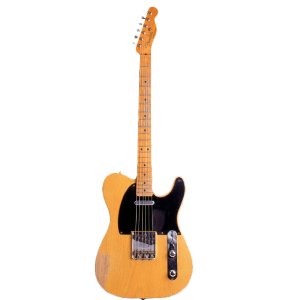
FENDER BROADCASTER, c.1950-1
This instrument, made between the end of 1950 and February 1951, sold originally for $169.95. Its 'back' (bridge) pickup, like those on other Broadcasters, Esquires and Telecasters, is angled to give the output from the upper strings an extra cutting edge; the unit can be raised and lowered to optimise its performance.
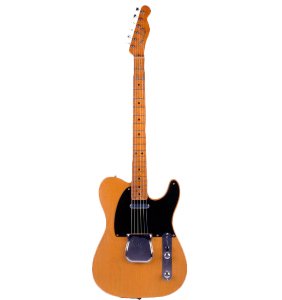
FENDER 'NO-CASTER', 1951
Aside from the lack of a model name on its headstock, the 'No-caster' seen here differs very little from Broadcasters and early Telecasters. Its bridge/pickup assembly is fitted with a removable metal cover (also supplied with other Telecaster-type Fenders) intended to shield the 'back' pickup from electrical interference and damage. Many players dislike this 'lid', and either discard it or use it as an ashtray!

FENDER TELECASTER, 1952
By 1952, the Telecaster's retail price had risen to $189.50, and the guitar was becoming an increasingly familiar sight on American bandstands. Like the Broadcaster and 'No-caster', this 'Tele' has a blond finish and a black pickguard.

FENDER ESQUIRE, 1957
This model boasts a custom sunburst finish. Note the absence of a 'front' (neck) pickup; the instrument's bridge transducer (hidden behind the cover) is identical to the Telecaster's. The three-way selector can activate a 'bassy' circuit like the Tele's (see below), and also allows the single pickup to be used with or without its rotary tone control (lower knob - the one above sets the volume).
Broadcasters/Telecasters were targetted at the busy professional player of the early 1950s, who would need to provide rhythm accompaniment, take solos, and sometimes even pick out bass lines on his instrument. Accordingly, the guitar offered three basic sounds, selected by the switch on the right of the strings: a 'rhythm guitar' tone from the neck ('front') pickup; a bassy timbre created by passing the front pickup signal through a special pre-set circuit; and a harder, more cutting 'lead' tone from the bridge ('back') pickup, which could be blended with the front pickup by adjusting the lower of the instrument's two knobs (the upper one is a volume control). In 1952, the 'blend' function was removed, and a regular tone control substituted. This meant that players could no longer combine the front and back pickups, and it was not until 1967 that the instrument was reconfigured in its 'modern' form, offering a choice of front, back, or front and back pickup selection. At this time, the 'bassy' circuit was abandoned; thanks to the popularity of the bass guitar - another Fender innovation - it had become an anachronism.
Between 1951 and 1965 (when Fender was sold to CBS - see below) several changes were made to the Telecaster's neck shape, and in 1959 the original all-maple neck was replaced by one with a rosewood fingerboard. There were also cosmetic changes to the body; a white pickguard was introduced in 1954, and soon afterwards, alternative finishes began to be offered (at a 5% surcharge) - at first in any colour of the player's choice, and later, in a range of specified 'custom colors.' A mahogany-bodied Telecaster was introduced in 1963, but discontinued two years later.
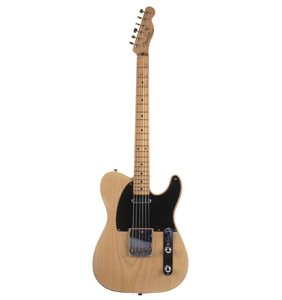
FENDER TELECASTER, 1954
This beautifully preserved instrument was one of the last 1954 Teles to be fitted with a black pickguard.
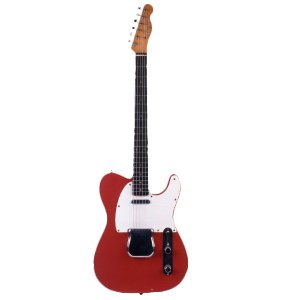
FENDER TELECASTER, 1959
The Fiesta Red finish seen here was one of the 'custom colours' offered by Fender to Telecaster purchasers. By the time of the CBS takeover in January 1965, other available options included Foam Green, Candy Apple Red and Daphne Blue, as well as sunburst, black and the original blond.
Leo Fender was not a man to rest on his laurels, and after launching the Telecaster and Esquire, he quickly turned his attention to new projects. His groundbreaking Precision bass guitar appeared in 1951, and his next 'electric Spanish' design, the Stratocaster, has proved to be one of the most influential and widely copied instruments of all time. Its name, conjuring up an image of high-flying modernity, was probably coined by Don Randall, who was to leave Radio-Tel and become President of Fender Sales Inc. in 1953.
The 'Strat' boasted an innovative double cutaway shape, with 'comfort contouring' on the back and at the point where the player rests his or her picking arm. It had three pickups, a patented vibrato system ('tremolo' in Fender nomenclature), and an innovative bridge setup allowing all six strings to be adjusted separately for length and height. Several of these features were introduced in response to customer criticisms of the Telecaster, whose body was considered by some players to be bulky and awkward, and whose bridge saddles (one for each pair of strings) did not permit precise intonation.
The Stratocaster was launched in 1954 with a fanfare of publicity that proclaimed it "years ahead in design - unequalled in performance." Like the Telecaster, it originally had an ash body and an all-maple neck; alder was later used for the body, and rosewood fingerboards were introduced in 1959. The guitar was given a sunburst finish as standard, with custom colours available at extra cost.
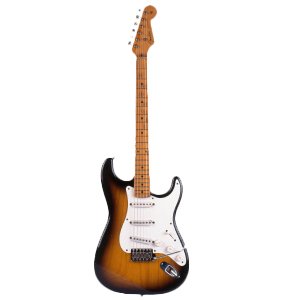
FENDER STRATOCASTER, 1954
A Stratocaster dating from the year the model was introduced. Sunburst finishes like this one were standard on the 'Strat' until 1958.
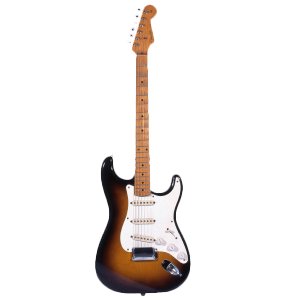
FENDER STRATOCASTER, 1957
This 'Strat' has a body made from alder (which began to be used instead of ash in 1956), and is fitted with a comparatively rarely seen metal bridge cover. Its vibrato arm has been removed, but the socket into which it screws is clearly visible.
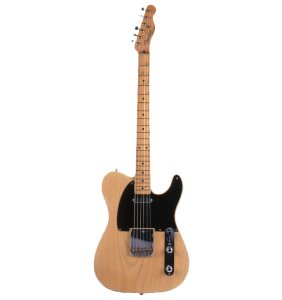
FENDER STRATOCASTER, 1958/60
A hybrid model, with a neck dating from 1958, and a body manufactured two years later. No vibrato is fitted; Stratocasters without what Fender termed 'synchronised tremolos' originally cost $20 less than those equipped with them.
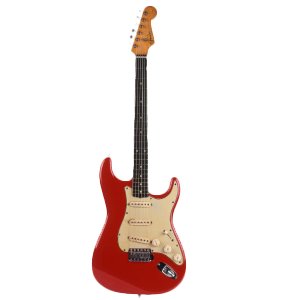
FENDER STRATOCASTER, 1961
The vintage Fiesta Red 'Strat' used by Mark Knopfler on his band Dire Straits' first major hit, Sultans of Swing, in 1979. Its vibrato arm has been removed.
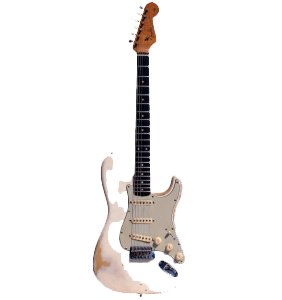
FENDER STRATOCASTER, 1962
This guitar's Olympic White finish has worn away on one side after many years' use. The instrument has a rosewood fingerboard, and an off-white three-ply pickguard (of the type used by Fender from the late 1950s to the mid-60s) whose slightly green tinge is caused by nitrates in its plastic.
Fender's "years ahead in design" claim for the Strat was certainly justified; in fact, some of the instrument's possibilities were not fully exploited until over a decade after its appearance. The vibrato/bridge unit, developed especially for the guitar, was able to produce far more dramatic effects than the gentle pitch fluctuations favoured by early Strat players. Unlike some other 'trems', it was able to keep the strings fairly well in tune after being used, and this encouraged an extreme use of its capabilities by 1960s and 70s musicians, notably Jimi Hendrix.
There was also more to the Strat's electronics than may have been intended by their designer. The pickups were selected by a three-position switch, below which were three knobs: an overall volume control, and separate tone controls for the neck and middle pickup. (The bridge pickup was wired straight to the volume knob.) When the switch was used in its three standard settings, only one pickup at a time could be activated; but guitarists soon learned how to balance it between these positions to give combinations of neck-and-middle and middle-and-bridge pickups, creating unexpected and distinctive tone-colours. Surprisingly, it was many years before Fender fitted a five-position switch, making these sounds easier to obtain.
In 1956 Fender unveiled two smaller-size electrics aimed chiefly at beginners, the Musicmaster and Duo-Sonic; but its next premier model was the Jazzmaster, introduced two years later. This featured new pickups, a shape designed to fit the contours of the player's body even more snugly than the Stratocaster, and a 'floating' vibrato system that could be disabled with a 'trem-lok' to allow easy restringing and to minimise tuning problems caused by string breakages. There were initial doubts about the Jazzmaster's appearance and feel. Forrest White, one of Leo's closest associates, remarked that it looked like a "pregnant duck", and other players were put off by its considerable weight. However, the guitar proved highly successful with 1950s and 60s pop groups, and later with punk and New Wave artists such as Elvis Costello.
During 1965, The Byrds' Mr. Tambourine Man and Turn! Turn! Turn!, featuring the distinctive tones of Jim McGuinn's 12-string electric Rickenbacker, were making a major impact on the charts. The time was right for Fender to capitalise on the sound of the moment with its Electric XII model, which appeared that summer. The new guitar's pickups were installed as two pairs of staggered units (an idea borrowed from the split-pickup configuration found on Fender's Precision basses from 1957 onwards). The combined tension of its extra strings made the provision of a vibrato unit impracticable; but Leo Fender's elaborate bridge design ensured that intonation could be set precisely. The Electric XII was not a great success, and was withdrawn in 1969.
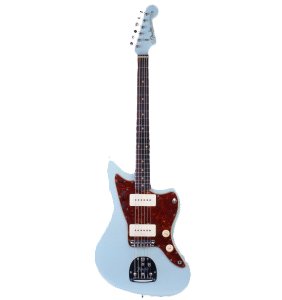
FENDER JAZZMASTER, 1960
A Jazzmaster with a Daphne Blue finish and an imitation tortoiseshell pickguard. The instrument's pickup controls (including 'roller type' adjusters for rhythm volume and tone to the left of the neck pickup) are designed to allow musicians to switch easily between 'lead' and 'rhythm' settings. The arm controlling the patented 'floating' vibrato has been removed.
Fender's follow-up to the Jazzmaster was its 1962 Jaguar model. It had many similarities to its predecessor, but was fitted with a 22-fret neck that had a shorter scale than previous full-size Fenders, and newly designed pickups incorporating notched metal screening as protection against electrical interference. It was less popular than the Jazzmaster, and was discontinued in 1974 - though it has since been reinstated.

FENDER JAGUAR, 1962
The Jaguar has a 24-inch (61cm) scale length - 1.5 inches (3.8cm) shorter than the Jazzmaster, Stratocaster, or Telecaster. Like the Jazzmaster, it features a floating vibrato and elaborate pickup switching options. It also has a string mute (positioned between the 'back' pickup and the bridge) designed to make string damping effects easier to produce.
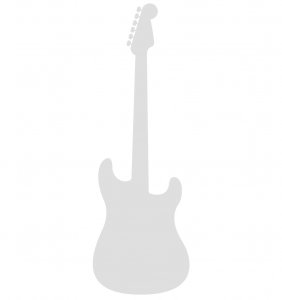
Fender Mustang 1964
The Fender Mustang, introduced in 1964, was a student model. It had a 24-inch (61cm) scale length, but was also available in a 22.5-inch (57.15cm) scale, like Fender's other beginners' instruments, the Musicmaster and Duo-Sonic. Compared to them, however, the Mustang had a much more sophisticated range of features, including yet another new 'floating' vibrato system, and sliding pickup switches offering a variety of tone settings. While the other Fender student guitars are rarely used by serious performers, the Mustang has developed something of a cult following over the years. One of its more recent high-profile devotees was Kurt Cobain of Nirvana, who made it the basis for his 'Jag-Stang' - the custom model that he played from 1993 until his death a year later. In 1996, Fender put a replica of this unusual design into regular production (see later).
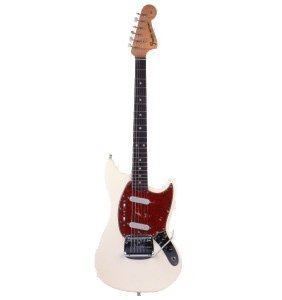
FENDER MUSTANG, 1965
Like the Jaguar, the Mustang has a 24-inch (61cm) scale; this example is finished in Olympic White. The design for its vibrato unit, featuring a floating bridge that moves backwards and forwards when the unit is activated, was patented in 1966. The Mustang's pickups are angled for optimum treble and bass response.
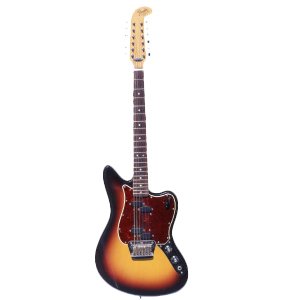
FENDER ELECTRIC XII, 1966
The Electric XII's distinctive headstock inspired an affectionate nickname - "the hockey stick." The guitar's pickups are switched by the black knob on the top right of the pickguard; they can be selected individually, combined, or fed through a pre-set tone circuit. This example has a sunburst finish; blond and custom Fender colours were also available.